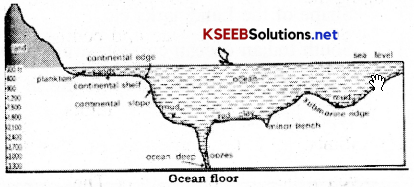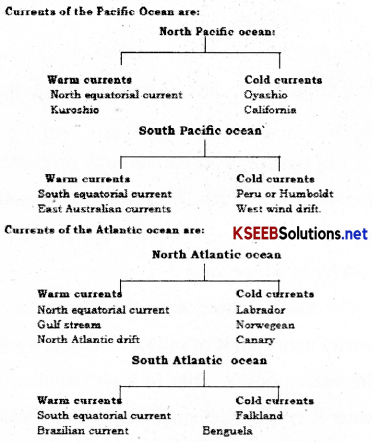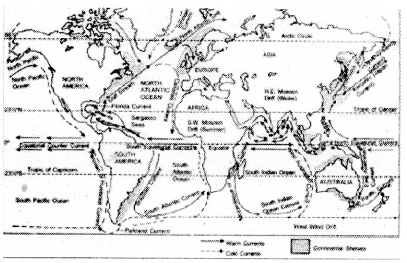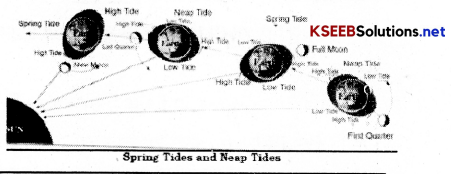Hydrosphere Class 8 Questions and Answers KSEEB 8th Social Science
I. Fill in the blanks with suitable words
Question 1.
The average depth of continental Shelf is _______________ .
Answer:
100 Fathoms.
Question 2.
One fathom is equal to _______________ ft
Answer:
6 ft
Question 3.
The deepest place in the Pacific ocean is _______________ .
Answer:
the Challenger deep.
![]()
Question 4.
The average salinity of the ocean water is _______________ .
Answer:
35 PPT
Question 5.
_______________ tides occur during full moon.
Answer:
Spring
II. Answer the following
Question 1.
What is hydrosphere?
Answer:
About 71 % of the total area of the earth or 361 million Sq. KM is covered by water is called water.
Question 2.
Mention the 4 major parts of the ocean floor is as follows.
Answer:
- The Continental shelf
- The Continental slope
- The Deep sea plain and
- The Ocean deeps.
Question 3.
State the difference between ocean currents and tides.
Answer:
Ocean currents are the regular movement of ocean water from one region to another. Ocean currents are two types- warm currents and cold currents. Tides are the periodic rise and fall in the sea or ocean level.
Tides occur due to gravitational attraction by the moon, gravitational force by the sun, rotation of the earth and centrifugal force of the earth. There are two types of tide, They are Spring tide and Neap tide.
Question 4.
Distinguish between spring tide and neap tides.
Answer:
Spring tides take place when the earth, the moon and the sun are in the same straight line. Ex: New moon and full moon night tides are the highest and lowest tides.
Neap tide: Neap tides occur on the first quarter and last quarter days in the phase of the moon. During neap tides the sun and the earth are in the same straight line and moon is in right angle to the earth. High tides are not very high and low tides are not very low.
![]()
Question 5.
How can we conserve the ocean
Answer:
(a) Oil transporation should be done through pipelines.
(b) Nuclear waste should not be dumped into the sea or ocean.
(c) Petro- chemical industries in the coastal regions must avoid dumping effluents into the sea or ocean.
(d) Dumping of any waste near the ports and harbours must be controlled.
Additional Questions and Answers
Question 1.
Write a figure of ocean floor
Answer:

Question 2.
Currents of the Pacific ocean are:
Answer:

Question 3.
Major ocean currents of the world
Answer:

![]()
Question 4.
Spring tides and neap tides
Answer:

III. Match the following
| A | B |
| 1. Fathom | a) deep sea Plain |
| 2. Oyashio | b) eastern coast of USA |
| 3. Gulf Stream | c) cold currents |
| 4. Sea mounts | d) Indian Ocean currents |
| 5. Aguilas Current | e) depth of ocean |
Answer:
1 – e
2 – c
3 – b
4 – a
5 – d
IV. Define the following
1. Continental shelf: This is the shallow area along the sea coast. This part is bordered by the sea coast on one side and continental, slope on the other side. The average depth of the continental shelf is 100 fathoms.
2. Salinity: It is the percentage of salts dissolved in the sea or ocean water. The average salinity of the ocean water is very high near the tropics and it is very low near the poles.
3. Warm and cold currents: These currents originate and flow from the equatorial regions to sub polar regions. These currents originate in the polar regions and flow towards the equatorial region.
4. High Tide and Low Tide: The high tide also known as flood tide and low tide also known as Ebb tide.
5. Benguela Current: It is a south Atlantic ocean cold current
6. Tides: Tides are the periodic rise and fall in the sea or ocean level.
![]()
IV. Terms to remember:
- Gulf stream, Warm current.
- Salinity. The percentage of salts dissolved in the sea or ocean water.
- Warm Currents: It originates and flow from the equatorial region towards polar regions.
- Kuroshio current: Honshu Hokkaido fishing grounds
- Flood tides: It is also known as high tides.
- Tidal energy: Generate electricity through tides.
III. Fill up the blanks.
Question 1.
______________ tides occur during full moon.
Answer:
Spring
Question 2.
The Sunlight can penetrate into the ocean only up to a depth of ______________
Answer:
200 meters.
Question 3.
The Salinity of dead sea is ______________
Answer:
300 ppt
Question 4.
The deepest print of the ocean is ______________
Answer:
Challenger deep
![]()
Question 5.
The salinity of water in Lake Sambar in India is ______________
Answer:
265 ppt
IV Answer the followings?
Question 1.
What are ocean trenches?
Answer:
The ocean deeps are also called ocean trenches.
Question 2.
How are tides useful to mankind. Tides help navigation.
Answer:
- It helps in the location of ports and harbours.
- Tide help to keep the harbours clean.
- They help fishing.
- They also help to generate energy in the form of tidal energy.
Question 3.
What are the major fishing grounds of the world ?
Answer:
(a) Honshu Hokkaido fishing grounds- meeting place of kuroshio warm current and oyashio cold current in Japan.
(b) Grand bank -meeting place of Gulf stream warm current and Labrador cold currents.
(c) Dagger bank- North Sea region of Europe.
Question 4.
Differentiate between warm currents and cold currents.
Answer:
Warm Currents: These currents originate and flow from the equatorial regions to sub-polar region.
Cold currents: These currents originate in the polar Regions and flow towards the equatorial region.
![]()
Question 5.
Why is water salty?
Answer:
The water flowing from the land to the sea carries many kinds of salts and deposit them in the sea or ocean. Due to high temperature, water is evaporated continuously, and the salts remain in the sea or ocean.
This continuous process ever along period or time has resulted in the accumulation of salts in the sea water.
Question 6.
What are oceans?
Answer:
Oceans are deep and Large expanse of water is found between the continents.
Ex: Pacific ocean, Atlantic ocean.
Question 7.
What is sea?
Answer:
Sea is a part of the ocean extended or projected far inland.
Ex. Arabian sea, Red sea
Question 8.
what is Bay?
Answer:
Bays are small semi-circular water bodies partially surrounded by land.
Question 9.
What is strait?
Answer:
Strait is narrow strip of water body Joining two large water bodies Ex. Palk strait, Strait of Gibraltar.
Question 10.
What Isthmus?
Answer:
Isthmus is a narrow stretch of land mase Joining two large Land mases.
Question 11.
What is salinity?
Answer:
Salinity is the percentage of salt dissolved in the sea or ocean water.
![]()
Question 12.
What are tides?
Answer:
Tides are the periodic rise and fall in the sea or ocean level.